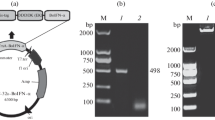Abstract
Interferon regulatory factor-1 (IRF-1) is a vertebrate transcription factor that plays significant roles in cell cycle regulation, anti-viral response, tumor suppression and immune response. High-level expression of recombinant IRF-1 at 37 °C leads to the formation of insoluble aggregates (insoluble fraction) in Escherichia coli (E. coli), which usually devoid of biological activity. In this study, we use chemical additives such as mannitol, proline, l-arginine and CTAB (cetyl trimethly ammonium bromide) at the recommended concentration during cell lysis to aid in solubility at 37 °C. The use of additives resulted in the increased solubility of the recombinant glutathione S-transferase-linked human IRF-1, with l-arginine being most effective. Here, we developed an efficient process for the manufacturing of soluble IRF-1 with the aid of minimizing the formation of degradation products and optimizing protein purification conditions. This result was further confirmed by western blot with anti-GST and anti-IRF-1 polyclonal antibodies. The functionality of GST-huIRF-1 was attained by elerophoretic mobility shift assay study as a clear band shifting showed with virus response element-Interferon beta (VRE-IFNβ) promoter region. Taken together, the biological activity of purified GST-huIRF-1 was also optimized and confirmed by supershift assay concluded that GST-huIRF-1 interacts with the VRE motif of IFNβ promoter that reflected to require for IFNβ gene regulation. We describe a straightforward approach for the production of absolutely soluble and biologically active IRF-1 in E. coli. This method can be further used for the study of other recombinant proteins and this study will pave way for the analysis of IRF-1 function in vitro.




Similar content being viewed by others
References
Alsamman K, El-Masry OS (2018) Interferon regulatory factor 1 inactivation in human cancer. Biosci Rep 38(3):BSR20171672
Tamura T, Yanai H, Savitsky D, Taniguchi T (2008) The IRF family transcription factors in immunity and oncogenesis. Annu Rev Immunol 26:535–584
Tanaka N, Ishihara M, Lamphier MS, Nozawa H, Matsuyama T, Mak TW, Taniguchi T (1996) Cooperation of the tumour suppressors IRF-1 and p53 in response to DNA damage. Nature 382(6594):816–818
Lee SH, Kim JW, Lee HW, Cho YS, Oh SH, Kim YJ, Lee JH (2003) Interferon regulatory factor-1 (IRF-1) is a mediator for interferon-γ induced attenuation of telomerase activity and human telomerase reverse transcriptase (hTERT) expression. Oncogene 22(3):381–391
Shao L, Hou W, Scharping NE, Vendetti FP, Srivastava R, Roy CN, Menk AV, Wang Y, Chauvin JM, Karukonda P, Thorne SH (2019) IRF1 inhibits antitumor immunity through the upregulation of PD-L1 in the tumor cell. Cancer Immunol Res 7(8):1258–1266
MacDonald NJ, Kuhl D, Maguire D, Näf D, Gallant P, Goswamy A, de la Fuente J (1990) Different pathways mediate virus inducibility of the human IFN-α1 and IFN-β genes. Cell 60(5):767–779
Mishra SK, Kumar N, Kumar G, Kashav T, Prakash K (2018) Recombinant human interferon regulatory factor-1 (IRF-1) protein expression and solubilisation study in Escherichia coli. Mol Biol Rep 45(5):1367–1374
Upreti M, Rath PC (2005) Expression and DNA binding activity of the recombinant interferon regulatory factor-1 (IRF-1) of mouse. Mol Biol Rep 32(2):103–116
Prakash K, Rath PC (2012) Mouse interferon regulatory factor-2: expression, purification and DNA binding activity. Mol Biol Rep 39(1):599–606
Baneyx F, Mujacic M (2004) Recombinant protein folding and misfolding in Escherichia coli. Nat Biotechnol 22(11):1399–1408
Francis DM, Page R (2010) Strategies to optimize protein expression in E. coli. Curr Protoc Protein Sci 61(1):5.24.1–29
Bondos SE, Bicknell A (2003) Detection and prevention of protein aggregation before, during, and after purification. Anal Biochem 316(2):223–231
Leibly DJ, Nguyen TN, Kao LT, Hewitt SN, Barrett LK, Van Voorhis WC (2012) Stabilizing additives added during cell lysis aid in the solubilization of recombinant proteins. PLoS One 7(12):e52482
Harada H, Willison K, Sakakibara J, Miyamoto M, Fujita T, Taniguchi T (1990) Absence of the type I IFN system in EC cells: transcriptional activator (IRF-1) and repressor (IRF-2) genes are developmentally regulated. Cell 63(2):303–312
Karki R, Sharma BR, Banoth B, Malireddi RS, Samir P, Tuladhar S, Mummareddy H, Burton AR, Vogel P, Kanneganti TD (2020) Interferon regulatory factor 1 regulates PANoptosis to prevent colorectal cancer. JCI Insight 5(12):e136720
Gupta A, Rath PC (2012) Expression, purification and characterization of the interferon-inducible, antiviral and tumour-suppressor protein, human RNase L. J Biosci 37(1):103–113
Reddy KRC, Lilie H, Rudolph R, Lange C (2005) L-Arginine increases the solubility of unfolded species of hen egg white lysozyme. Protein Sci 14(4):929–935
Nakagawa K, Yokosawa H (2000) Degradation of transcription factor IRF-1 by the ubiquitin–proteasome pathway: the C-terminal region governs the protein stability. Eur J Biochem 267(6):1680–1686
Bandyopadhyay A, Saxena K, Kasturia N, Dalal V, Bhatt N, Rajkumar A, Chakraborty K (2012) Chemical chaperones assist intracellular folding to buffer mutational variations. Nat Chem Biol 8(3):238–245
Acknowledgements
The researchers thank current and past members of the Central University of South Bihar for helpful discussions and research fellowships from the UGC to Santosh Kumar Mishra.
Author information
Authors and Affiliations
Corresponding author
Ethics declarations
Conflict of interest
The authors declare that they have no conflict of interest.
Ethical approval
This article does not contain any studies with human participants performed by any of the authors.
Additional information
Publisher's Note
Springer Nature remains neutral with regard to jurisdictional claims in published maps and institutional affiliations.
Rights and permissions
About this article
Cite this article
Mishra, S.K., Verma, R., Kumari, P. et al. A rapid method for solubilization of chimeric human interferon regulatory factor-1 (IRF-1) protein in Escherichia coli. Mol Biol Rep 48, 2307–2314 (2021). https://doi.org/10.1007/s11033-021-06260-w
Received:
Accepted:
Published:
Issue Date:
DOI: https://doi.org/10.1007/s11033-021-06260-w




